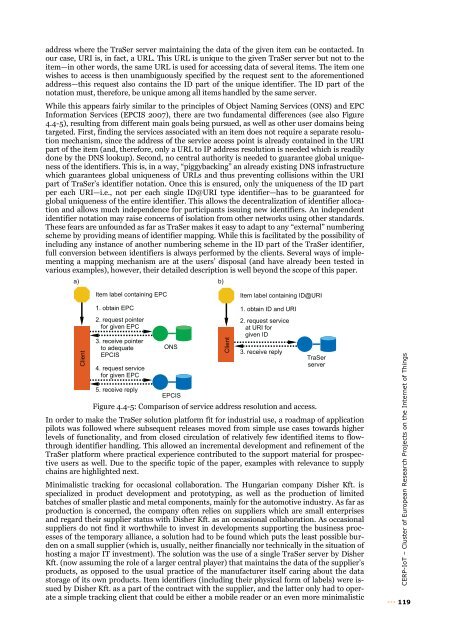Vision and Challenges for Realising the Internet of Things
Vision and Challenges for Realising the Internet of Things
Vision and Challenges for Realising the Internet of Things
Create successful ePaper yourself
Turn your PDF publications into a flip-book with our unique Google optimized e-Paper software.
address where <strong>the</strong> TraSer server maintaining <strong>the</strong> data <strong>of</strong> <strong>the</strong> given item can be contacted. In<br />
our case, URI is, in fact, a URL. This URL is unique to <strong>the</strong> given TraSer server but not to <strong>the</strong><br />
item—in o<strong>the</strong>r words, <strong>the</strong> same URL is used <strong>for</strong> accessing data <strong>of</strong> several items. The item one<br />
wishes to access is <strong>the</strong>n unambiguously specified by <strong>the</strong> request sent to <strong>the</strong> a<strong>for</strong>ementioned<br />
address—this request also contains <strong>the</strong> ID part <strong>of</strong> <strong>the</strong> unique identifier. The ID part <strong>of</strong> <strong>the</strong><br />
notation must, <strong>the</strong>re<strong>for</strong>e, be unique among all items h<strong>and</strong>led by <strong>the</strong> same server.<br />
While this appears fairly similar to <strong>the</strong> principles <strong>of</strong> Object Naming Services (ONS) <strong>and</strong> EPC<br />
In<strong>for</strong>mation Services (EPCIS 2007), <strong>the</strong>re are two fundamental differences (see also Figure<br />
4.4-5), resulting from different main goals being pursued, as well as o<strong>the</strong>r user domains being<br />
targeted. First, finding <strong>the</strong> services associated with an item does not require a separate resolution<br />
mechanism, since <strong>the</strong> address <strong>of</strong> <strong>the</strong> service access point is already contained in <strong>the</strong> URI<br />
part <strong>of</strong> <strong>the</strong> item (<strong>and</strong>, <strong>the</strong>re<strong>for</strong>e, only a URL to IP address resolution is needed which is readily<br />
done by <strong>the</strong> DNS lookup). Second, no central authority is needed to guarantee global uniqueness<br />
<strong>of</strong> <strong>the</strong> identifiers. This is, in a way, “piggybacking” an already existing DNS infrastructure<br />
which guarantees global uniqueness <strong>of</strong> URLs <strong>and</strong> thus preventing collisions within <strong>the</strong> URI<br />
part <strong>of</strong> TraSer’s identifier notation. Once this is ensured, only <strong>the</strong> uniqueness <strong>of</strong> <strong>the</strong> ID part<br />
per each URI—i.e., not per each single ID@URI type identifier—has to be guaranteed <strong>for</strong><br />
global uniqueness <strong>of</strong> <strong>the</strong> entire identifier. This allows <strong>the</strong> decentralization <strong>of</strong> identifier allocation<br />
<strong>and</strong> allows much independence <strong>for</strong> participants issuing new identifiers. An independent<br />
identifier notation may raise concerns <strong>of</strong> isolation from o<strong>the</strong>r networks using o<strong>the</strong>r st<strong>and</strong>ards.<br />
These fears are unfounded as far as TraSer makes it easy to adapt to any “external” numbering<br />
scheme by providing means <strong>of</strong> identifier mapping. While this is facilitated by <strong>the</strong> possibility <strong>of</strong><br />
including any instance <strong>of</strong> ano<strong>the</strong>r numbering scheme in <strong>the</strong> ID part <strong>of</strong> <strong>the</strong> TraSer identifier,<br />
full conversion between identifiers is always per<strong>for</strong>med by <strong>the</strong> clients. Several ways <strong>of</strong> implementing<br />
a mapping mechanism are at <strong>the</strong> users’ disposal (<strong>and</strong> have already been tested in<br />
various examples), however, <strong>the</strong>ir detailed description is well beyond <strong>the</strong> scope <strong>of</strong> this paper.<br />
Figure 4.4-5: Comparison <strong>of</strong> service address resolution <strong>and</strong> access.<br />
In order to make <strong>the</strong> TraSer solution plat<strong>for</strong>m fit <strong>for</strong> industrial use, a roadmap <strong>of</strong> application<br />
pilots was followed where subsequent releases moved from simple use cases towards higher<br />
levels <strong>of</strong> functionality, <strong>and</strong> from closed circulation <strong>of</strong> relatively few identified items to flowthrough<br />
identifier h<strong>and</strong>ling. This allowed an incremental development <strong>and</strong> refinement <strong>of</strong> <strong>the</strong><br />
TraSer plat<strong>for</strong>m where practical experience contributed to <strong>the</strong> support material <strong>for</strong> prospective<br />
users as well. Due to <strong>the</strong> specific topic <strong>of</strong> <strong>the</strong> paper, examples with relevance to supply<br />
chains are highlighted next.<br />
Minimalistic tracking <strong>for</strong> occasional collaboration. The Hungarian company Disher Kft. is<br />
specialized in product development <strong>and</strong> prototyping, as well as <strong>the</strong> production <strong>of</strong> limited<br />
batches <strong>of</strong> smaller plastic <strong>and</strong> metal components, mainly <strong>for</strong> <strong>the</strong> automotive industry. As far as<br />
production is concerned, <strong>the</strong> company <strong>of</strong>ten relies on suppliers which are small enterprises<br />
<strong>and</strong> regard <strong>the</strong>ir supplier status with Disher Kft. as an occasional collaboration. As occasional<br />
suppliers do not find it worthwhile to invest in developments supporting <strong>the</strong> business processes<br />
<strong>of</strong> <strong>the</strong> temporary alliance, a solution had to be found which puts <strong>the</strong> least possible burden<br />
on a small supplier (which is, usually, nei<strong>the</strong>r financially nor technically in <strong>the</strong> situation <strong>of</strong><br />
hosting a major IT investment). The solution was <strong>the</strong> use <strong>of</strong> a single TraSer server by Disher<br />
Kft. (now assuming <strong>the</strong> role <strong>of</strong> a larger central player) that maintains <strong>the</strong> data <strong>of</strong> <strong>the</strong> supplier’s<br />
products, as opposed to <strong>the</strong> usual practice <strong>of</strong> <strong>the</strong> manufacturer itself caring about <strong>the</strong> data<br />
storage <strong>of</strong> its own products. Item identifiers (including <strong>the</strong>ir physical <strong>for</strong>m <strong>of</strong> labels) were issued<br />
by Disher Kft. as a part <strong>of</strong> <strong>the</strong> contract with <strong>the</strong> supplier, <strong>and</strong> <strong>the</strong> latter only had to operate<br />
a simple tracking client that could be ei<strong>the</strong>r a mobile reader or an even more minimalistic<br />
CERP-IoT – Cluster <strong>of</strong> European Research Projects on <strong>the</strong> <strong>Internet</strong> <strong>of</strong> <strong>Things</strong><br />
119
















